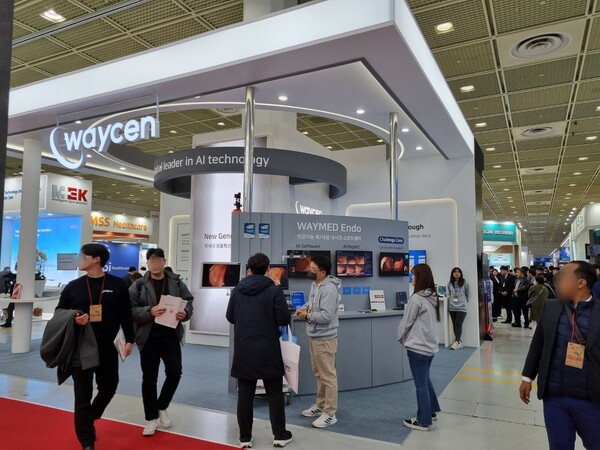The 39th Korea International Medical and Hospital Equipment Show (KIMES) 2024, which opened on Thursday, attracted visitors' attention with more than 13,000 products related to the medical industry, especially AI-based smart healthcare and robotics.
KIMES 2024, which will continue through Sunday, more than 1,350 Korean and foreign manufacturers will introduce convergent medical devices, hospital facilities, medical information systems, healthcare and rehabilitation devices, and medical supplies.
For instance, AI medical tech company Waycen introduced AI digestive endoscopy image analysis software “Waymed Endo” and AI respiratory self-screening service “Waymed Cough.”

Waymed Endo is a software that uses AI technology to analyze endoscopic images in real-time during gastrointestinal and colon endoscopy and display abnormal areas.
Waymed Endo was the first AI endoscope licensed by the Ministry of Food and Drug Safety (MFDS) and was designated as the ministry's No. 37 innovative medical device in July last year. Waycen supplies Waymed Endo to many hospitals in Korea and abroad, including Gangneung Asan Hospital, National Health Insurance Service Ilsan Hospital, VHS Medical Center, and Gangneung Medical Center.
Waycen is also introducing its AI-based digital treatment devices, “Waymed Food Allergy” and “Waymed Panic,” at the exhibition, which it plans to introduce to the market.
Another AI medical tech company, VUNO, highlighted its AI-based chronic disease management brand, “Hativ.” The personal electrocardiogram (ECG) measuring device, “Hativ P30,” is a device that can measure the ECG by simply standing on the leg certified by the MFDS. The “Hativ Care” app allows users to manage health information, such as ECG, blood pressure, blood sugar, and weight, by linking with other products in the Hativ line and storing information.
VUNO also introduced several other products from the Hativ family that can be used in conjunction with the Hative Care app, including Hativ EX, software for medical staff to monitor ECGs of patients with suspected arrhythmias, Hativ BP30T, a home automatic sphygmomanometer, and Hativ TP30, a thermometer.
Also drawing the attention of participants were AITRICS, which developed “VC (VitalCare),” a solution for early detection and prediction of changes in a patient's condition using six vital signs and 11 blood tests based on AI; AIVIS, which developed “PathoAID-Colorectal” and “AIVIS-BREAST,” an AI solution for cancer diagnosis using H&E-stained histopathology images; Claripi, which developed “ClariCT.AI,” a solution for CT noise removal and image quality improvement; and AiMEDIC, which developed an AI solution for cardiovascular disease diagnosis based on cardiac CT images.
Products utilizing robotics technology also caught the eyes of visitors.

Curexo, a medical robotics company, has introduced “CUVIS-joint,” an artificial joint surgery robot, and “Morning Walk S200,” a gait rehabilitation robot. CUVIS-joint is a fully automated artificial joint surgery robot capable of navigation-based automatic cutting. As 3D data based on CT images, it enables accurate surgical planning for each patient's condition, and a robotic arm that minimizes human errors such as slight tremors enables clean cross-sectional cuts.
Morning Walk S200 is a seated, weight-bearing, foot-powered gait rehabilitation robotic system that reduces treatment preparation time with easy boarding. The MFDS has approved it, and is currently being used in more than 30 university hospitals.
HUCA System introduced HUCA-Go, a walking rehabilitation robot for patients with brain lesions, stroke, and Parkinson's disease. HUCA-Go is a Class 3 medical device used under the control of medical staff in specialized treatment centers. It can customize speed and stride length according to the patient's gait type. By wearing the HUCA-Go harness, patients can use more of their own lower body strength.
"AI and robotics are new technologies that fit the fourth industrial era," an industry executive said. “Their high compatibility and versatility will contribute to the advancement of the medical device industry and provide patients with more effective treatment and customized medical services."

